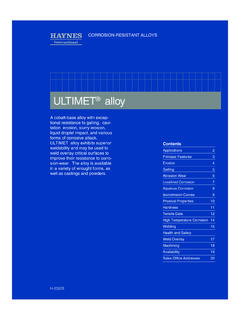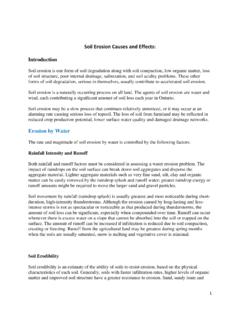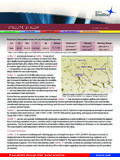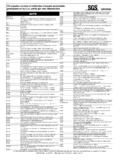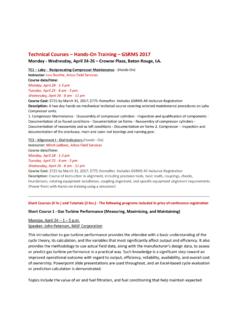Transcription of Plastic Injection Molding Glossary - apisolution.com
1 Glossary of Plastic Injection Molding Terms abrasion Resistance: The ability of a material to withstand mechanical actions such as rubbing, scraping, or erosion , that tend progressively to remove material from its surface. Acceptable runner/cavity ratio: runner systems designed for high pressure drops to minimize material usage and increase frictional heating in the runner. Additive: A substance compounded into a resin to enhance or improve certain characteristics. Adhesive Assembly: The process of joining two or more Plastic parts by means of an adhesive.
2 Aging: The process of, or the results of, exposure of plastics to natural or artificial environmental conditions for a prolonged period of time. Air Burn: A patch or streak of brown or black material on the component caused by air or gases that have not been properly vented from the mold and have caused the material to overheat and burn. Alloy: A term used in the plastics industry to denote blends of polymers or copolymers with other polymers or elastomers. - ABS/Polycarbonate. Ambient Temperature: The temperature of a medium surrounding an object.
3 The term is often used to denote prevailing room temperature. Amorphous: Devoid of crystallinity or stratification. Most plastics are amorphous at processing temperatures. Material assumes more random molecular structure when cooling. Anisotropy: The tendency of a material to react differently to stresses applied in different directions. Annealing: The process of relieving internal stresses of molded Plastic articles by heating to a predetermined temperature, maintaining this temperature for a predetermined length of time, and slowly cooling the articles.
4 ANSI: Abbreviation for American National Standards Institute. Antioxidant: Additive used to reduce degradation from oxygen attack at normal or elevated temperatures. Sources such as heat, age, chemicals, and/or stress may accelerate oxygen attack. Antiozonants: These additives are used to prevent the negative effects of ozone on the resin materials. Antistatic Agent: Additive used to improve the electrical conductivity of the Plastic part so that any charge can readily go to ground and not remain in the part. Application: The act of applying or putting to use.
5 What the molded Plastic article will be in its final form. Artificially balanced runner system: balancing a runner system by adjusting the pressure drop of a long large diameter runner against a short small diameter runner. Since pressure drop over the small diameter runner will be much more affected by heat loss than the large diameter runner, an artificially balanced runner system will work with a set range of Molding conditions. The width of this range of Molding conditions determines the stability of the Molding . Ash Content: The solid residue remaining after a substance has been incinerated or heated to a temperature sufficient to drive off all combustible or volatile substances.
6 Aspect Ratio: Ratio of total flow length to average wall thickness. Assembly: The process of joining parts by any of several methods. A-stage: This is a very early stage in the reaction of certain thermosetting resins where the molecular weight is low and the resin is still soluble in some liquids and still fusible. ASTM: Abbreviation for American Society for Testing and Materials. Back Pressure: The resistance of the molten Plastic material to forward flow. In Molding , back pressure increases the temperature of the melt, and contributes to better mixing of colors and homogeneity of the material.
7 However, as back pressure increases, so does cycle time. Backflow: molten resin flows back out of the mold, returning to the runners. Backing Plate: A plate used as a support for the mold cavity block, guide pins, bushings, etc. Balanced Runner: A runner system designed to place all cavities at the same distance from the sprue. Barrel: The section of a Molding machine that contains the feed screw, also the section where resin heating and mixing occurs. Binder: A resin or other material used to hold particles together. The binder is the continuous phase in a reinforced Plastic , which provides mechanical strength or ensures uniform consistency, solidification, or adhesion to a surface coating.
8 Typical binder materials include resin, glue, gum and casein. Biocides & Fungicides: Additives that are used to inhibit the growth and colonization of fungus, bacteria, and other pests. Black Specks: A specific kind of inclusion/contamination often associated with heat-degraded materials. Blast Finishing: The process of removing flash from molded objects and/or dulling their surfaces, by impinging upon them with sufficient force to remove the flash. Blister: An imperfection on the surface of a Plastic article caused by a pocket of air or gas beneath the surface.
9 Blocking & Anticaking Agents: These additives are used to prevent the adhesion and agglomeration of ingredients within a resin compound. Bloom (also know as Migration): An undesirable cloudy effect or whitish powdery deposit on the surface of a Plastic article or to the surrounding environment caused by the exudation of an ingredient such as a lubricant, stabilizer pigment, plasticizer, or other non-bonded component. Blow Molding : Method of fabrication in which a warm Plastic hollow tube is placed between the two halves of a mold cavity and forced to assume the shape of that mold cavity by use of internal pressure.
10 This process forms hollow articles such as bottles, tanks, etc. Blowing & Foaming Agents: Additives for plastics or rubbers that generate inert gases within the resin matrix when heated. The resulting part construction will contain a cellular structure. Blushing: The tendency of a Plastic article to turn white or chalky in areas that are highly stressed. Boss: A raised feature of a molded part designed to add strength, facilitate alignment during assembly or for attachment to another part. Branching: The modification of the molecular structure of a polymer derived from the growth of a new polymer chain from an active site on an established chain, in a direction different from that of the original chain.

